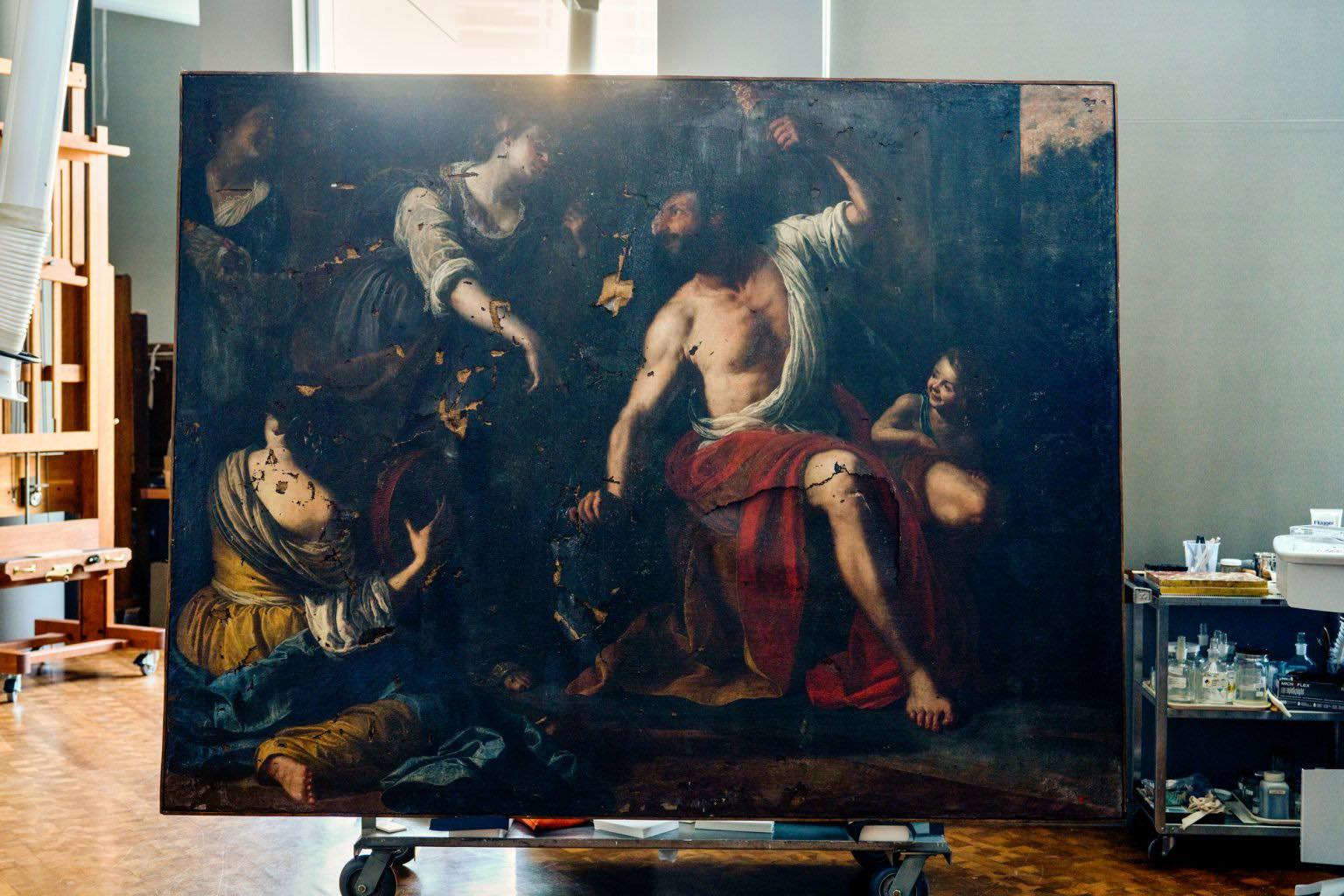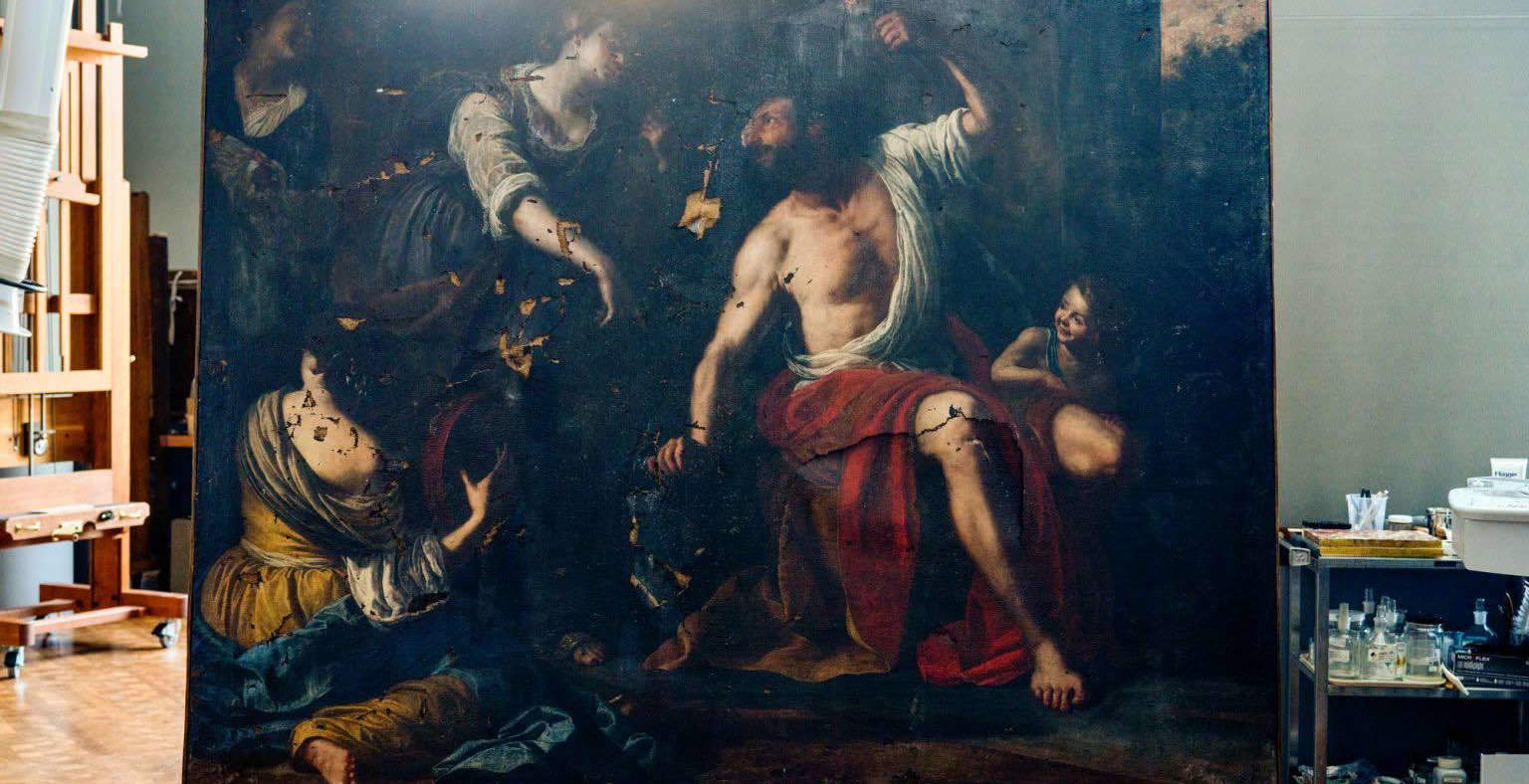On the heights of Santa Monica, within the spaces of the Getty Museum in Los Angeles, a never-before-seen fragment of Italian art history finds its place. From June 10 to September 14, the California institution presents the exhibition Artemisia’s Strong Women: Rescuing a Masterpiece, entirely dedicated to Artemisia Gentileschi. At the center of the exhibition is a painting never before shown to the public: Hercules and Onphale, a work attributed to the Baroque painter, which has been restored after suffering extensive damage from the explosion that struck the port of Beirut on Aug. 4, 2020. The canvas depicts one of the lesser-known stories of Greek mythology, that of the hero Hercules, who was forced to serve Onphale, queen of Lydia, as punishment for killing Iphitus. The hero, stripped of his mythical masculinity and subjected to female roles, is depicted in the act of spinning with a spindle, while the sovereign observes the scene. The image, in keeping with Gentileschi’s interest in reversals of power and gender roles, brings to light a narrative that fits consistently into the painter’s body of work, known for her strong, self-aware female figures.
Until the 2020 explosion, Hercules and Onphale was stored inside the Sursock Palace, a historic early 20th-century building located in Beirut’s Achrafieh neighborhood, also home to the museum of the same name. The explosion, caused by the detonation of more than 2,700 tons of ammonium nitrate stored without safety measures in the city’s port, claimed more than 200 lives and devastated entire neighborhoods. In addition to the human and social effects, the deflagration hit Beirut’s cultural heritage hard, severely damaging the palace and its collections. Immediately after the disaster, Lebanese art historian Gregory Buchakjian published an article lamenting the loss or damage of numerous works of art. Among those mentioned appeared Hercules and Onphale, which he attributed to Artemisia Gentileschi, emphasizing its historical importance. The work was severely compromised: affected by glass fragments, rubble and metal debris, the canvas had multiple holes, tears, lifts and a layer of settled dirt, making it difficult to accurately assess its state of preservation.
In 2022, the work was transferred to the United States, where it found a home in the Getty Museum’s restoration laboratories. The paintings’ chief conservator, Ulrich Birkmaier, led the recovery effort, which required a painstaking approach. The first step was the manual removal of all blast residue, followed by the removal of old restoration work and altered paint. The restoration, carried out in collaboration with Roman colleague Matteo Rossi Doria, made it possible to recover the painting’s original color range, restore the paint surface, and reconstruct the missing parts in a manner respectful of the original drafting. According to reports from the Getty, the work made it possible to restore the canvas’s original formal coherence and legibility, while leaving visible traces of the trauma suffered. In line with the latest international guidelines, the intervention aimed to maintain a balance between respect for the work’s history and the need to make it usable again.

"The discovery of Gentileschi’sHercules and Onphale in Beirut was a momentous event for art historians around the world," says Timothy Potts, director of the Getty Museum. “We are grateful to the Sursock Palace for entrusting us with the task of restoring this masterpiece to its former glory and displaying it in the museum’s galleries, along with other depictions of strong women by Gentileschi.”
"We believe Hercules and Onphale was painted in the 1630s in Naples, where Artemisia moved in 1630 and lived for the rest of her life (she died there between 1654 and 1656, ed.)," says Davide Gasparotto, senior curator of paintings at the Getty Museum.
“In my more than 30-year career as a painting restorer, this is some of the most serious damage I’ve ever seen and it was one of the most challenging, but also most rewarding, projects I’ve worked on,” says the Getty’s chief conservator, Ulrich Birkmaier. “It was a bit like assembling a huge jigsaw puzzle: little by little the painting came back to life.”
After the California exhibition concludes, the painting will travel across the country to be housed at the Columbus Museum of Art, Ohio, where it will remain on public view until spring 2026. After that, the canvas will return to the Getty for a long-term loan, which will ensure its preservation in a controlled environment, while waiting for the Sursock Palace to welcome it back to its rooms.
 |
| Artemisia Gentileschi, the work saved from the Beirut explosion on display at the Getty in Los Angeles |
Warning: the translation into English of the original Italian article was created using automatic tools. We undertake to review all articles, but we do not guarantee the total absence of inaccuracies in the translation due to the program. You can find the original by clicking on the ITA button. If you find any mistake,please contact us.